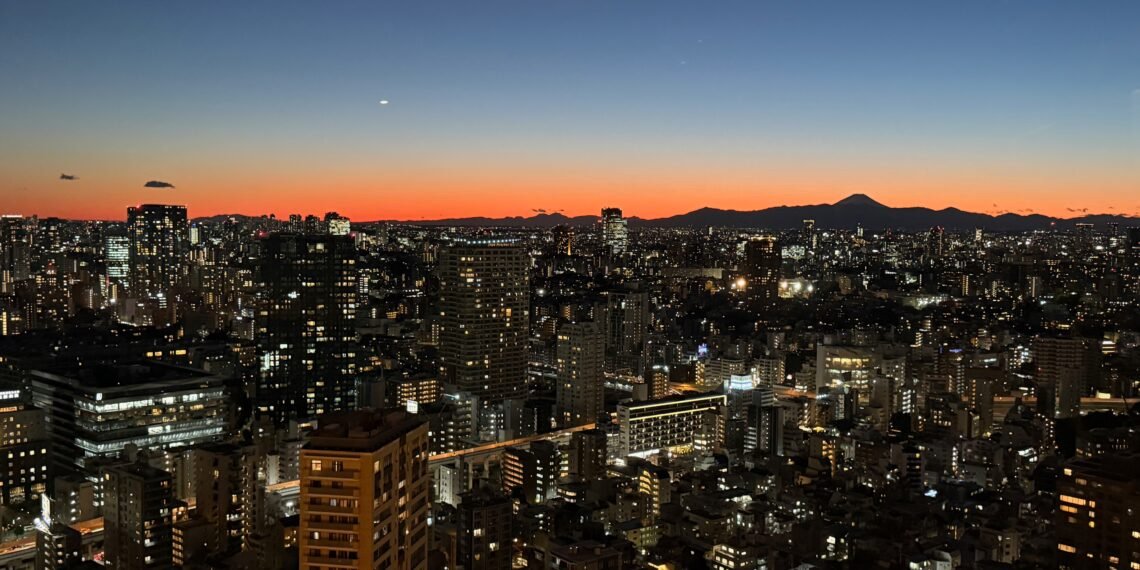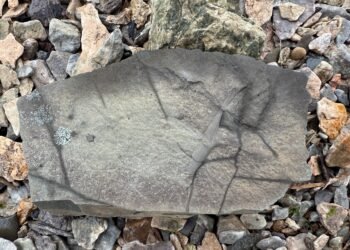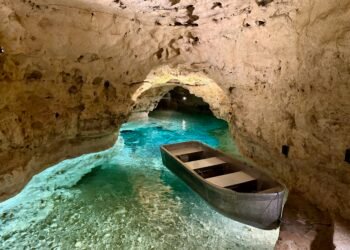On a crisp January evening in Tokyo, I ascended the iconic Tokyo Tower to witness a sunset I’ll never forget. With Mount Fuji silhouetted on the horizon and the city glowing beneath me, I found not only beauty but science in the fading light. This is the story of that winter sunset – where atmosphere, color, and curiosity met high above Japan’s capital.
1 Tokyo Tower Sunset: Chasing Light from the Tower Above
t was my third trip to Japan, but my first during the cold hush of January. Tokyo in winter feels different: the air is sharper, the skies clearer, and the light more honest somehow. I had come for a short stay, revisiting favourite places like Akihabara, Odaiba, plus the Miraikan science museum and the National Museum of Nature and Science.
During this visit, I stayed once again at the Hotel Monterey Hanzomon – my second time booking this clean and centrally located Tokyo hotel. It’s right across from the Hanzomon Line subway, which made exploring the city effortless. While the rooms are compact (as most are in Tokyo), they’re spotless, quiet, and comfortable – a solid base for science-minded travelers. If you’re still planning your stay, you can also browse more Tokyo hotel options.
But there was one thing I hadn’t done before – at least, not like this.
I wanted to watch the sun set over Tokyo from the iconic Tokyo Tower.
2 Quick Facts About the Tokyo Tower
- Location: Tokyo Tower, Minato City, Tokyo, Japan.
- Built: Completed in 1958.
- Height: 333 m (1,093 ft) tall.
- Observation Deck Heights: Main Deck – 150 m (492 ft), Top Deck – 250 m (820 ft).
- Best Time to Visit: Clear winter days around 30 minutes before sunset.
- Admission: ¥1,500 ($10 USD) for the Main Deck.
3 A Winter Quest for Light
Coming back from Miraikan on a cool, crisp afternoon, I made my way across the city toward the bright red lattice of the Tokyo Tower. Rising 333 m (1,093 ft) into the air, it’s often overshadowed these days by the sleeker Tokyo Skytree, but for me, Tokyo Tower has a kind of nostalgic elegance, a structure that belongs both to the city’s post-war dreams and its enduring present. I had been up it before, but never at this hour. Never for this purpose.
By 4:15 pm, I was at the entrance, ticket in hand, and taking the smooth elevator ride to the main observation deck at about 150 m (492m ft). Sunset was expected just after 4:40 pm – a surprisingly early hour, but not unusual for January in the Northern Hemisphere. I was right on time.
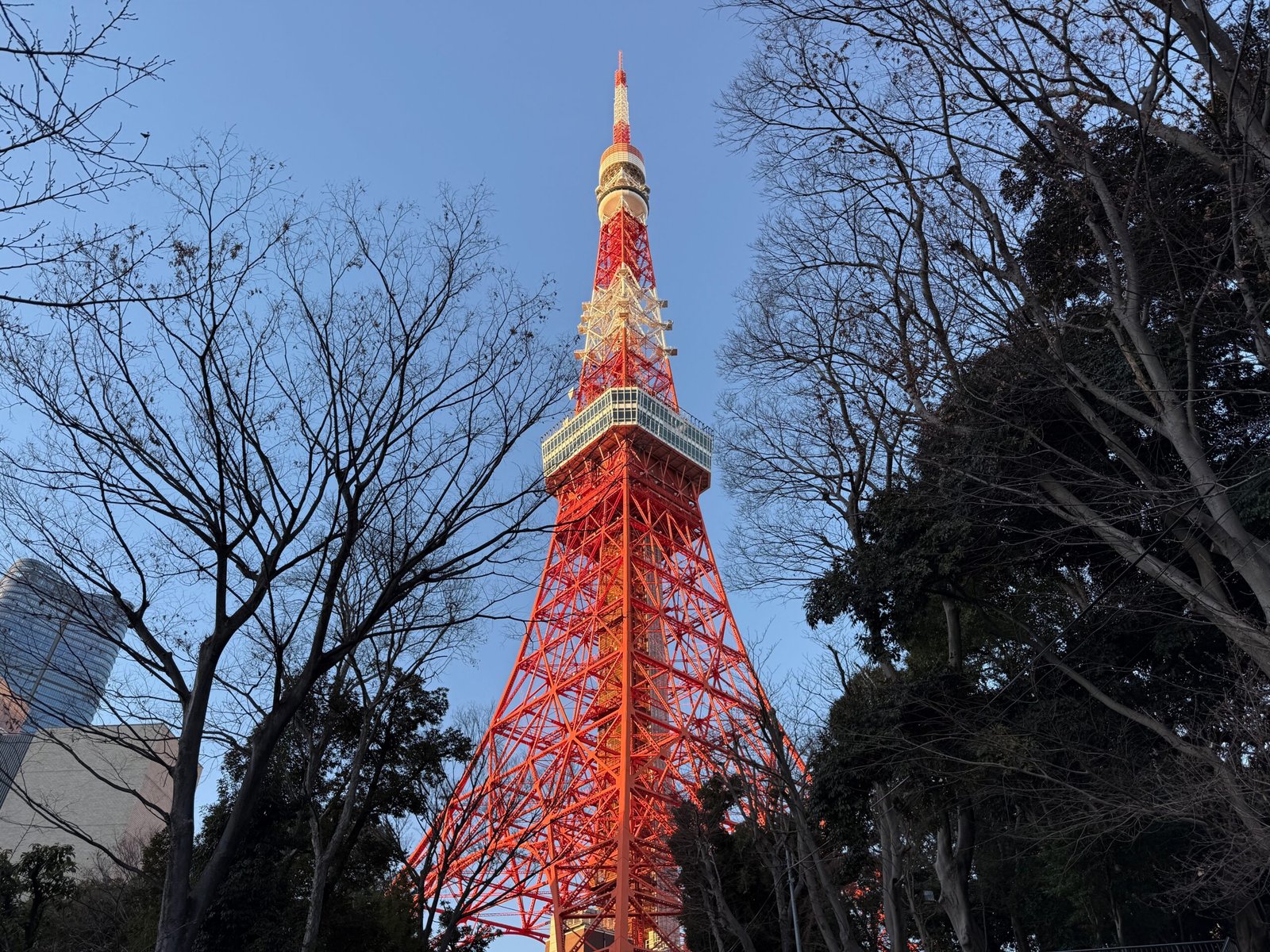
At this time of year, the Earth is tilted in such a way that the sun hovers near its lowest point in the sky, just above the Tropic of Capricorn – an imaginary line that runs just south of the equator. With the sun tracing a shallow arc across Tokyo’s winter sky, daylight fades quickly, and timing becomes everything.
To my surprise, the western-facing windows weren’t yet crowded. I found a quiet spot, set down my backpack, and let myself be still. Before me, the city sprawled in every direction – a maze of glinting rooftops, winding rail lines, and clusters of skyscrapers. And then, something extraordinary happened.
In the distance, almost perfectly aligned with the descending sun, rose the sacred silhouette of Mount Fuji.
4 A Beacon from the Past: The History of Tokyo Tower
Long before I stood at its windows watching the sun dip behind Mount Fuji, Tokyo Tower stood as a symbol of hope, renewal, and scientific ambition.
Completed in 1958, Tokyo Tower rose during Japan’s postwar recovery, which was an era of rebuilding, redefining, and reaching for the future. Inspired by the Eiffel Tower in Paris, but painted in bright white and international orange to comply with aviation safety regulations, it was the tallest structure in Japan at the time.

Its purpose was both symbolic and practical: to broadcast television and radio signals across the Tokyo region during a time when Japanese households were just beginning to adopt TV sets. For decades, Tokyo Tower served as the primary broadcasting hub for the Kanto area – its lattice steel body quietly transmitting entertainment, news, and culture into living rooms across the country.
But it wasn’t just about media. Tokyo Tower became a national icon and a visual shorthand for Tokyo itself. It appeared in movies, anime, and postcards, often representing Japan’s intersection of tradition and modernity. Even after taller structures like the Tokyo Skytree surpassed it, Tokyo Tower remains beloved with its retro-futuristic design and central location still drawing millions of visitors each year.
Now used for a mix of tourism and digital broadcasting, Tokyo Tower has shifted roles but never lost its presence. At night, it glows with seasonal light shows – sometimes gold, sometimes pink, sometimes sparkling white for special events. And for me, it was the perfect place to watch the sky change over this ever-evolving city.
5 Mount Fuji in the Frame
There are few sights in the world as quietly powerful as Fuji-san on a clear winter evening. Even from 46 km (30 mi) away, the great stratovolcano loomed large, an unmistakable cone carved from Earth’s long memory.
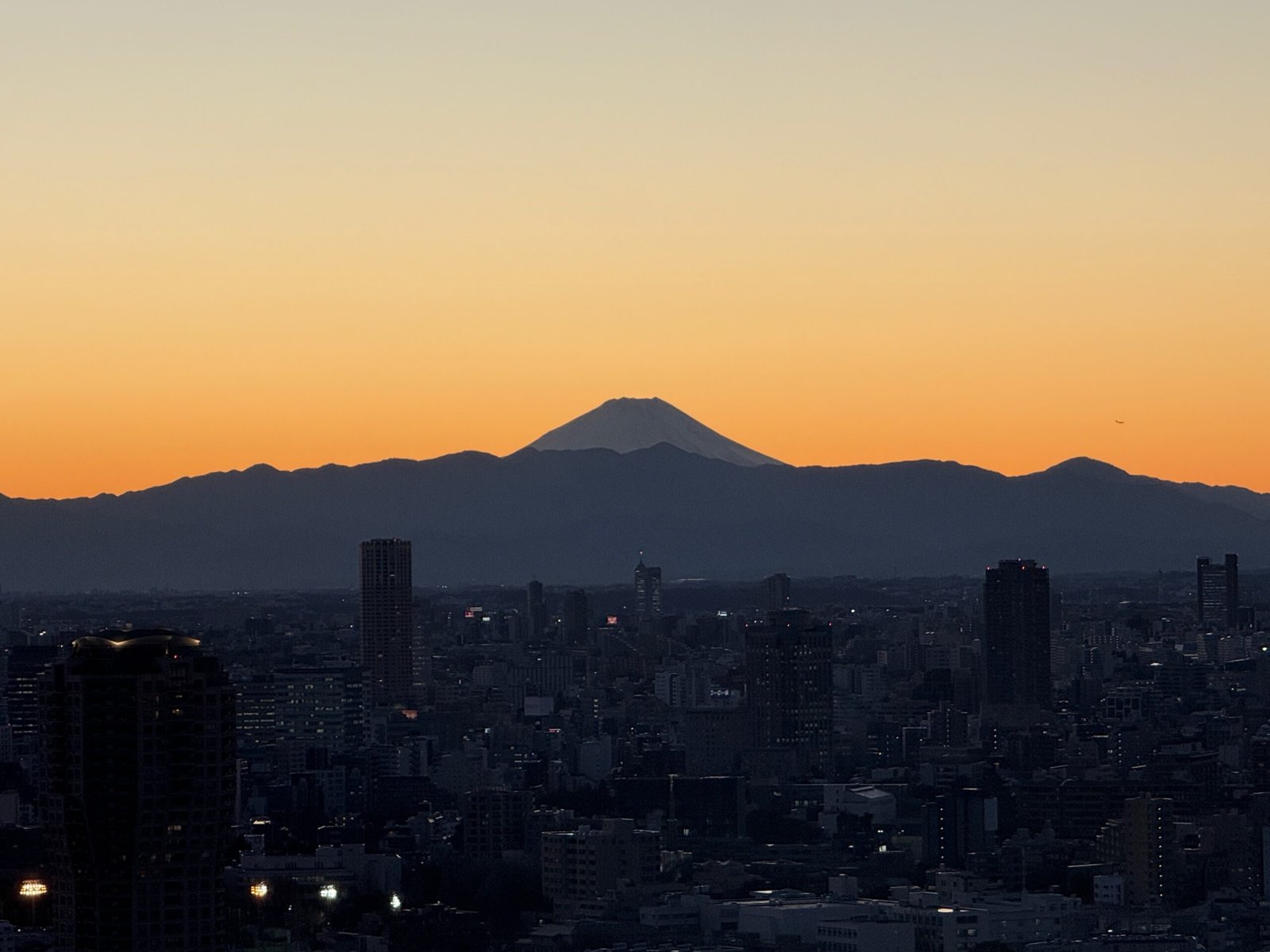
It felt symbolic somehow: the transient beauty of a sunset, framed by the patient permanence of a volcano. In Japanese culture, Fuji is both sacred and symbolic – an axis of spiritual stillness amid the chaos of modern life. And here it was, framed in gold light, waiting.
6 You Might Also Like:
- Miraikan Tokyo: Where Science Shapes Tomorrow – Explore Tokyo’s Museum of Emerging Science and Innovation, where robots, AI, and deep-space missions offer a glimpse into humanity’s future.
- National Museum of Nature and Science Tokyo: What to See – Step inside Japan’s premier natural history museum, where dinosaurs, evolution, and Earth-science exhibits bring billions of years to life.
- Aiguille du Midi: An Engineering Marvel Above Chamonix – Journey to the summit of the French Alps to discover the geology, history, and engineering behind Chamonix’s most iconic high-altitude mountain station.
7 Why Sunsets Glow
As I stood in that moment, I found myself thinking about the science behind sunsets and why they enchant us so deeply, and what’s actually going on in the sky.
Sunsets are a symphony of scattering. As sunlight enters Earth’s atmosphere, it collides with molecules of air, dust, and water vapour – a phenomenon known as Rayleigh scattering. This process preferentially scatters shorter wavelengths of light, like blues and violets, in all directions, which is why our daytime sky appears blue.
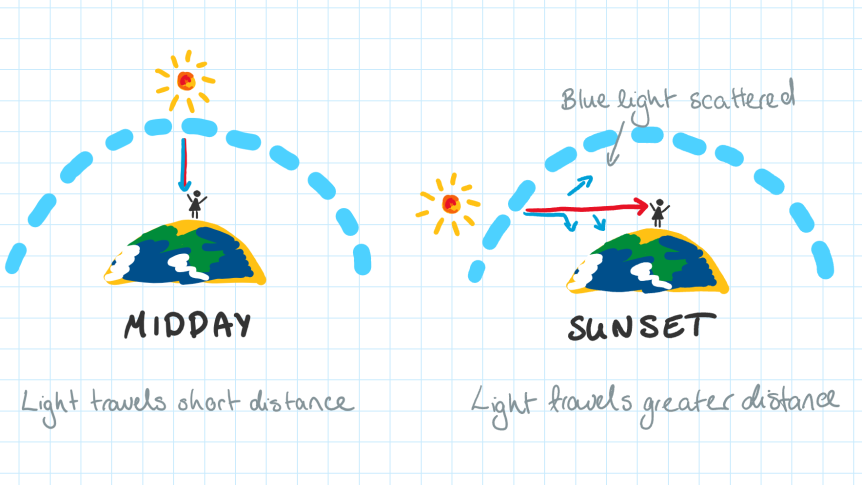
Credit: ABC Weather: Kate Doyle
But at sunset, when the sun is low on the horizon, its light has to pass through a much thicker slice of atmosphere. The blues and greens are scattered away almost completely, leaving behind the longer wavelengths, like the vivid reds, oranges, and deep golds, to paint the sky.
When there’s just the right mix of particles, such as urban haze, natural dust, and a few high-altitude clouds, sunsets can become electric.
Tokyo, a megacity wrapped in winter air and backlit by the setting sun, seemed to offer the perfect atmospheric recipe that evening.
A Shared Moment at 150 Metres
At about 4:40pm, a shift swept across the room. The once-quiet windows filled with people – some tourists like me, others professional photographers with long lenses and heavy gear. I stood beside them, my iPhone 16 Pro Max in hand, feeling no less ready to capture the moment.
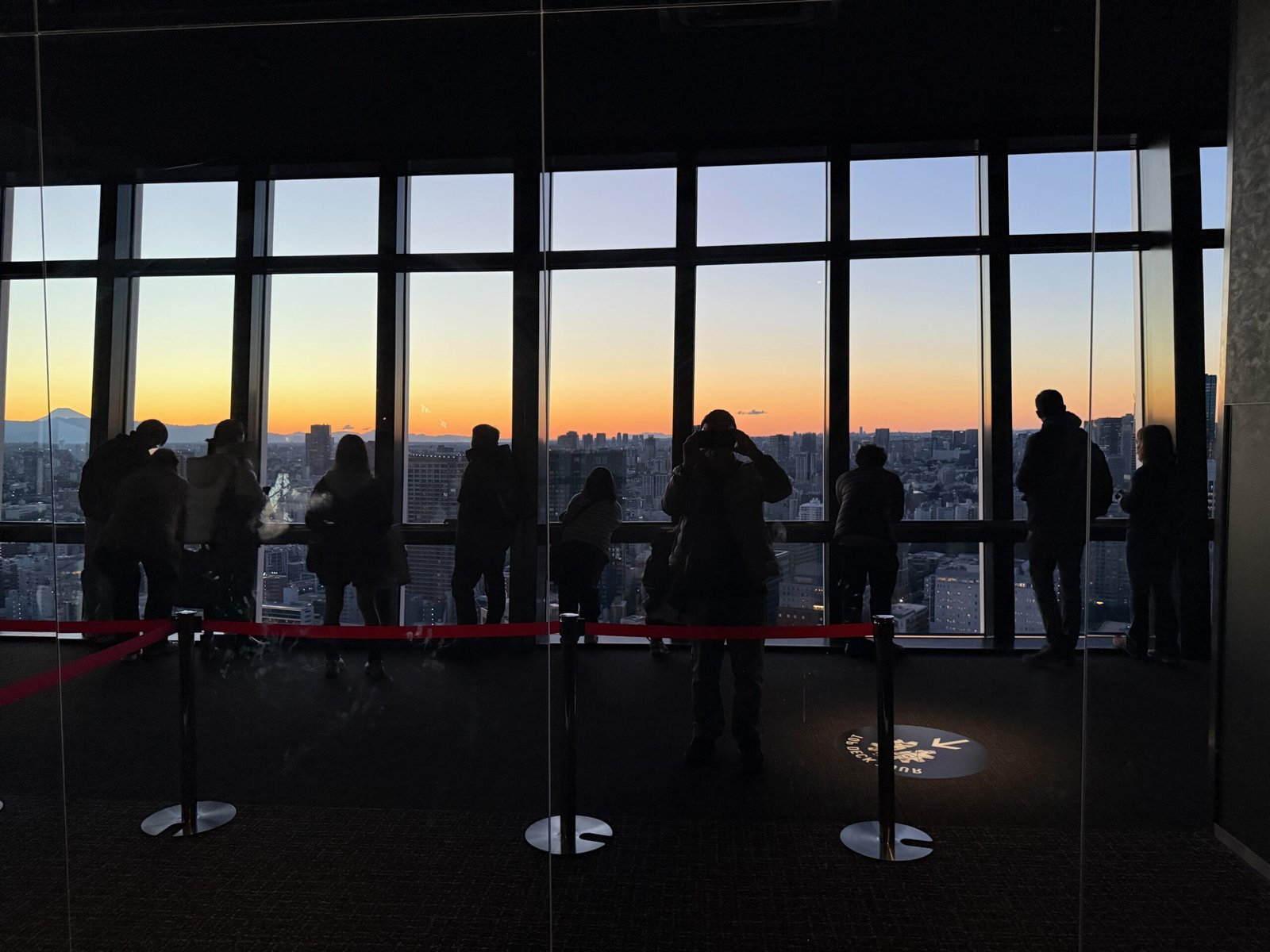
And then it came.
The sun touched the hills west of Tokyo, glowing like molten copper. The city itself dimmed, as if bowing to the light. Mount Fuji, now lit from behind, took on a dark majesty with its silhouette sharp and its symbolism undeniable.
A collective hush fell across the room, broken only by the soft clicks of cameras and quiet gasps of wonder.
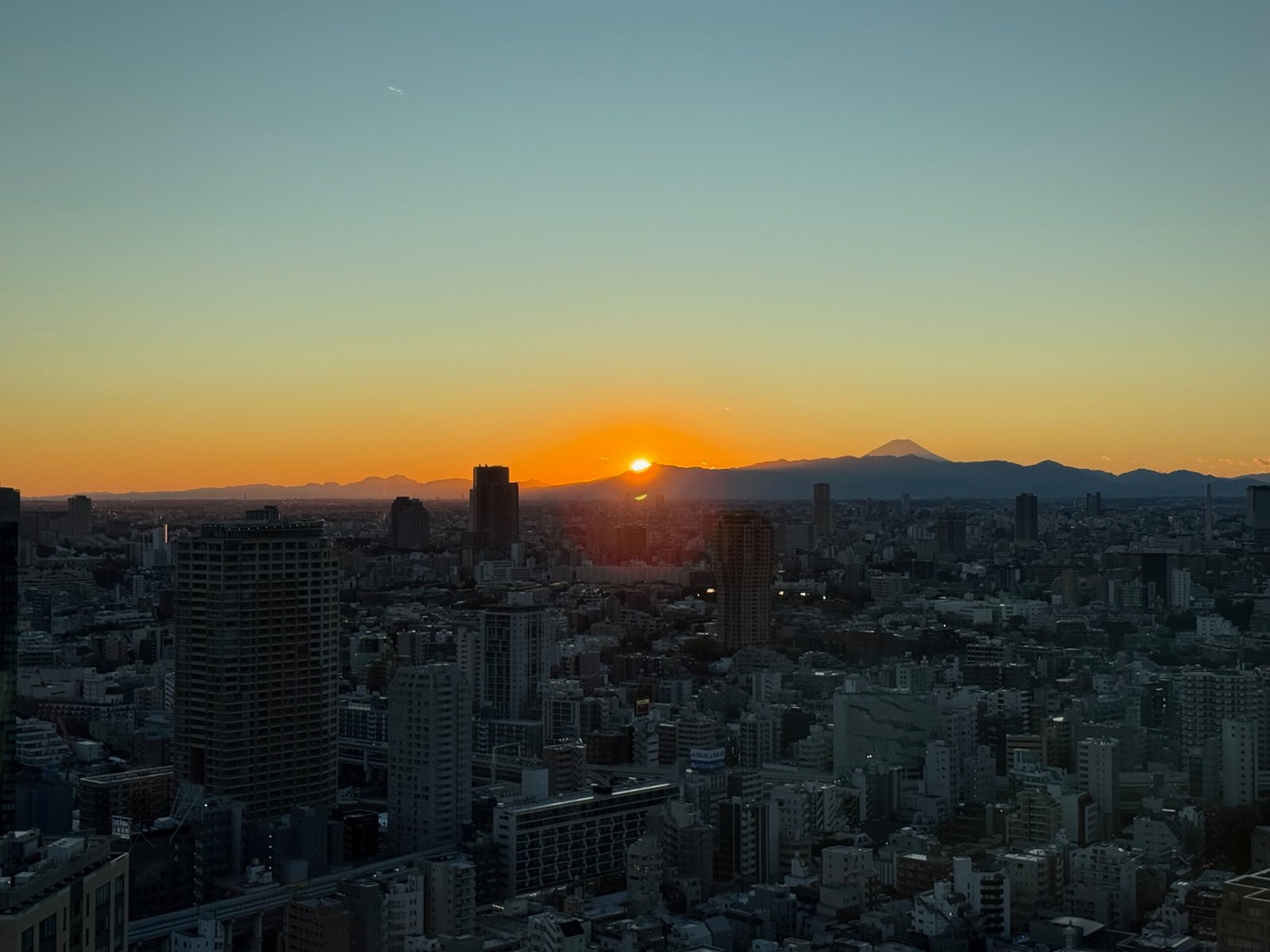
9 Into the Night
Even after the sun disappeared, I stayed.
As the sky faded from gold to indigo, Tokyo came alive in another way. Lights flickered on like stars, but these were artificial ones this time, with tiny red beacons blinking atop every building, pulsing like a heartbeat. I assumed they were aviation lights, marking the sprawl for the many helicopters and planes that cross the city’s sky. But their rhythm felt almost intentional – like the city was breathing.
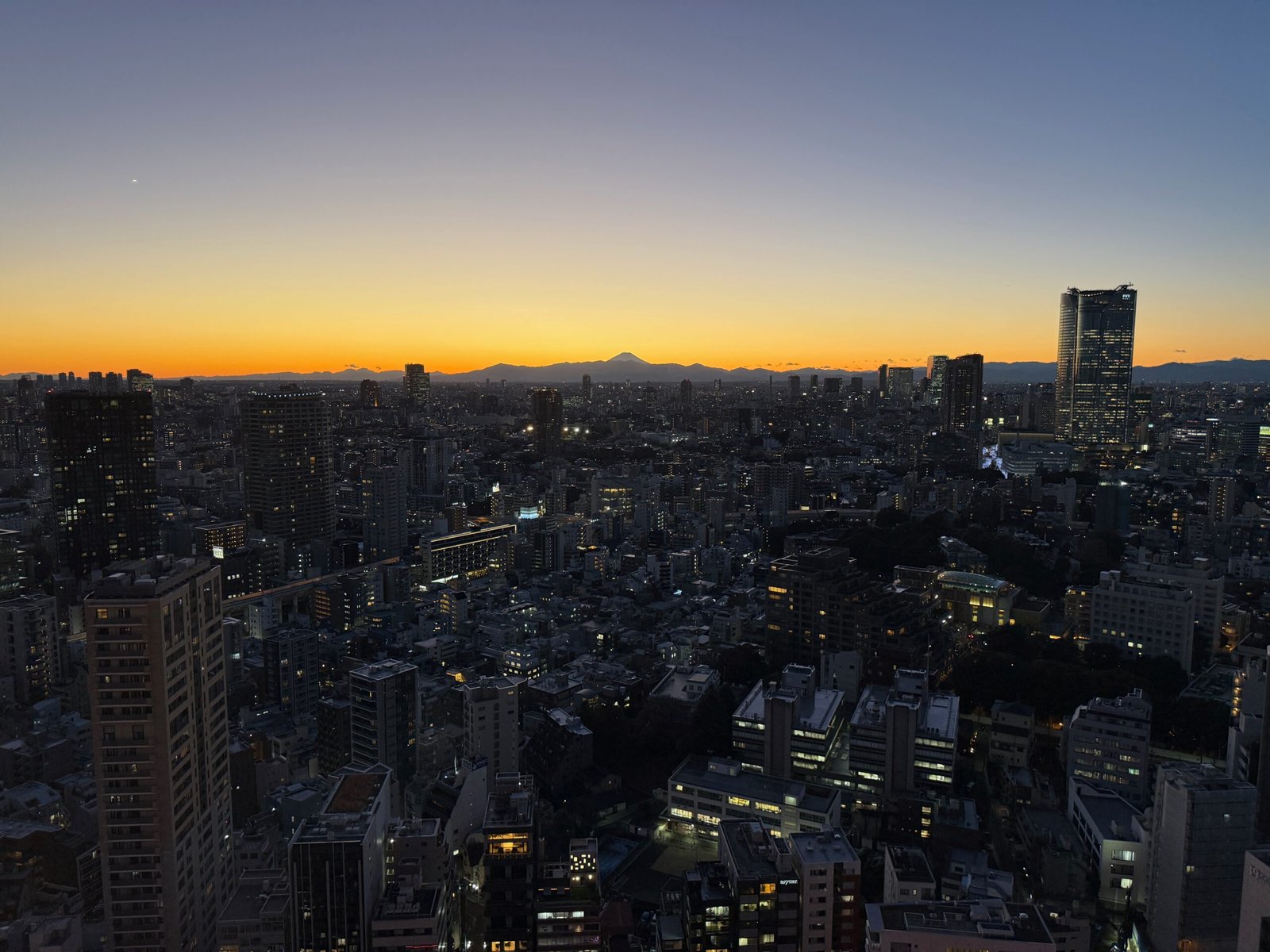
Tokyo at night is a kind of dream. From above, it feels endless: a city not defined by a single skyline, but by a sea of luminous motion.
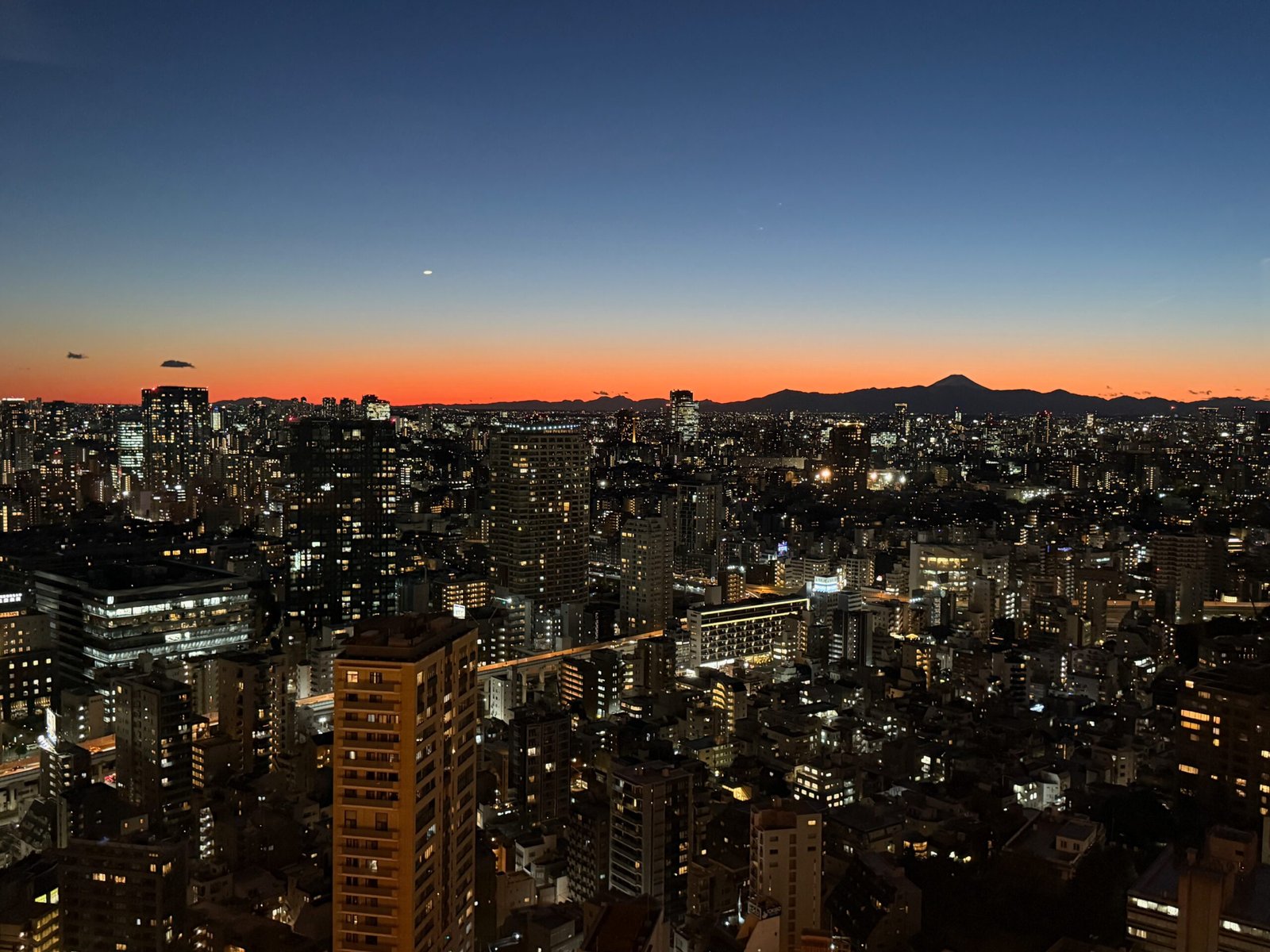
10 The Tower After Dark
Eventually, I made my way down, the elevator dropping me gently back to street level. Outside, the tower stood illuminated in its signature warm orange and yellow glow, shining like a lantern against the darkening sky.

I took a moment to look up – past the steel, past the lights, past the urban noise, and thought about what I had just seen. Not just the sunset. Not just Mount Fuji. But the way it all came together: the science, the city, and the stillness of a shared human experience.
11 Practical Tips for Viewing a Tokyo Tower Sunset
Whether you’re chasing the perfect sunset or just planning your Tokyo Tower visit, these tips will help you make the most of the moment.
- Best Time for Sunset: In winter, sunset in Tokyo occurs early and later in the evening during summer. Arrive about 30 minutes early to secure a spot by the west-facing windows.
- Observation Deck Access: The Main Deck (150m) is included with general admission; the Top Deck Tour (250m) requires an upgraded ticket. Either level offers great views, but the Main Deck is usually enough for sunset and skyline photography.
- Admission Price: ¥1,500 ($10 USD) for the Main Deck. Tickets can be bought in advance online or at the tower entrance.
- Visibility of Mount Fuji: Clear winter days offer the best chance to see Mount Fuji – especially when humidity is low and skies are crisp.
- Photography: Tripods aren’t allowed inside, but smartphones and handheld cameras are welcome. The iPhone 16 Pro Max handled the lighting conditions impressively.
- Post-Sunset Experience: Stay after the sun sets! Tokyo’s skyline comes alive with red aviation beacons and city lights – perfect for night photography.
- Access: Tokyo Tower is easily reachable by metro; Akabanebashi Station (Oedo Line) is the closest, with several other stations nearby.
12 Pro Tips for Science Travelers
If you see the world like I do through a lens of curiosity and at a cosmic scale, these science-rich details will make your sunset experience even more meaningful.
- Watch the Atmosphere at Work: Sunsets are an ideal real-world display of Rayleigh scattering – the same physics that explains why skies are blue during the day and red-orange at dusk.
- Look for Atmospheric Layers: On very clear days, you may spot temperature inversion layers in the distance, appearing as thin horizontal bands of haze that add depth to sunset colour gradients.
- Mount Fuji as a Geological Icon: The silhouette of Mount Fuji isn’t just beautiful – it’s a stratovolcano shaped by Japan’s subduction zones. Think of it as a geologic ambassador visible from the future-facing Tokyo Tower.
- Light Pollution Awareness: While Tokyo is bright, observing the transition from solar to artificial light is a striking way to experience the shift from natural to human-altered environments.
- Bring Binoculars: Not just for Fuji – watch for urban heat plumes, aerial traffic, the detailed slopes of Mount Fuji, or even distant aircraft silhouetted against the glowing sky.
13 FAQs About the Tokyo Tower Sunset
What’s the best time to visit Tokyo Tower for sunset?
Sunset in Tokyo occurs around 4:40 pm in January, though times vary slightly throughout the year. Check for the sunset time on the date of your visit and plan to be there about 30 minutes beforehand.
Can you really see Mount Fuji from Tokyo Tower?
Yes! On clear winter days, Mount Fuji can be seen silhouetted on the western horizon. While it’s about 46 km (28 mi) away, the dry air and low humidity of winter provide the best visibility. Fuji often appears in a soft haze just before sunset.
Why are Tokyo Tower sunsets so colourful?
It all comes down to Rayleigh scattering. As the sun sets, its light travels through a thicker layer of atmosphere, scattering shorter blue wavelengths and allowing longer red and orange wavelengths to dominate. In a city like Tokyo with urban haze, cool air, and high-altitude clouds, the result can be electric.
What’s the science behind Rayleigh scattering?
Rayleigh scattering occurs when molecules in Earth’s atmosphere scatter shorter wavelengths of light (blue and violet) more effectively than longer ones (red and orange). At sunset, sunlight passes through more atmosphere, so the blues are scattered away, leaving warmer tones behind.
Where is the best place in Tokyo Tower to view the sunset?
The Main Deck at 150 metres offers a wide west-facing window wall that perfectly frames the sunset and Mount Fuji. While the Top Deck at 250 metres offers a more panoramic view, many visitors find the Main Deck more accessible and equally stunning.
Do I need a tripod or special camera gear to photograph the sunset?
Not at all! Handheld cameras and smartphones (like my iPhone 16 Pro Max) work very well from the observation deck. Tripods aren’t allowed, but stable window ledges and low-light modes make capturing the moment easy.
Is Tokyo Tower better than Tokyo Skytree for sunset views?
Both offer spectacular views, but Tokyo Tower has a nostalgic charm and a direct west-facing view toward Mount Fuji, making it ideal for winter sunsets. It’s also centrally located, and the lower altitude can sometimes provide better ground-level contrast at twilight.
14 Final Reflections
I’ve watched sunsets from many places including mountaintops, islands, coastlines, but something about this one stayed with me. Maybe it was the contrast: the ancient volcano against the ultra-modern city, the hush of the crowd in the middle of Tokyo, the orange blaze of a star dipping beneath Earth’s curve.
Or maybe it was just that I had slowed down long enough to notice.
As I walked away into the Tokyo night, I didn’t just feel like a visitor. I felt like someone who had seen something sacred, something fleeting, but full of meaning.
One day, I’ll return to Tokyo, drawn again by the promise of that brief and breathtaking light.

